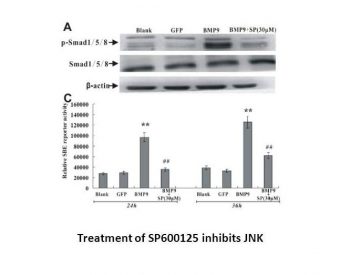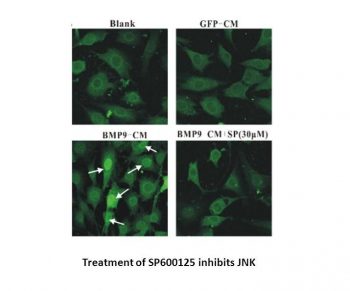| CAS NO: | 129-56-6 |
| 规格: | ≥98% |
| 包装 | 价格(元) |
| 50mg | 电议 |
| 100mg | 电议 |
| 250mg | 电议 |
| 500mg | 电议 |
| 1g | 电议 |
| 2g | 电议 |
| 5g | 电议 |
| Molecular Weight (MW) | 220.23 |
|---|---|
| Formula | C14H8N2O |
| CAS No. | 129-56-6 |
| Storage | -20℃ for 3 years in powder form |
| -80℃ for 2 years in solvent | |
| Solubility (In vitro) | DMSO: 44 mg/mL (199.8 mM) |
| Water: <1 mg/mL | |
| Ethanol:<1 mg/mL | |
| Solubility (In vivo) | 5% DMSO+corn oil: 5 mg/mL |
| Synonyms | SP 600125; SP-600125; SP600125 Chemical Name: dibenzo[cd,g]indazol-6(2H)-one InChi Key: ACPOUJIDANTYHO-UHFFFAOYSA-N InChi Code: InChI=1S/C14H8N2O/c17-14-9-5-2-1-4-8(9)13-12-10(14)6-3-7-11(12)15-16-13/h1-7H,(H,15,16) SMILES Code: O=C1C2=C3C(NN=C3C4=CC=CC=C14)=CC=C2 |
| In Vitro | In vitro activity: SP600125 is originally characterized as a selective ATP-competitive inhibitor of c-Jun N-terminal kinase JNK. In Jurkat T cells, SP600125 inhibits the phosphorylation of c-Jun with IC50 of 5 μM to 10 μM. In CD4+ cells, such as Th0 cells isolated from either human cord or peripheral blood, SP600125 blocks cell activation and differentiation and inhibits the expression of inflammatory genes COX-2, IL-2, IL-10, IFN-γ, and TNF-α, with IC50 of 5 μM to 12 μM. However, later studies reveal that SP600125 also suppresses aryl hydrocarbon receptor (AhR), Mps1, and a panel of other serine/threonine kinases, including Aurora kinase A, FLT3, MELK, and TRKA. In a mouse beta cells MIN6, SP600125 (20 μM) induces the phosphorylation of p38 MAPK and its downstream CREB-dependent promoter activation. In HCT116 cells, SP600125 (20 μM) blocks the G2 phase to mitosis transition and induces endoreplication. This ability of SP600125 is independent of JNK inhibition, but due to its inhibition of CDK1-cyclin B activation upstream of Aurora A and Polo-like kinase 1. Kinase Assay: The potency of SP600125 towards kinases, including MPS1, JNK, and Aurora kinase A, is determined based on the specific measurement of radioactive phosphotransfer to the substrate. For each enzyme, the absolute Km values for ATP and the specific substrate are initially determined and each assay is then run at optimized [ATP] (2·αKm) and [substrate] (5·Km) concentrations. MPS1 activity is measured using 5 nM of MPS1 recombinant protein in 50 mM HEPES pH 7.5, 2.5 mM MgCl2, 1 mM MnCl2, 1 mM DTT, 3 μM NaVO3, 2 mM β-glycerophosphate, 0.2 mg/mL BSA, 200 μM P38-βtide substrate-peptide (KRQADEEMTGYVATRWYRAE), and 8 μM ATP with 1.5 nM 33P-γ-ATP. Ten serial 1:3 dilutions (from 30 μM to 1.5 nM) of SP600125 are tested and IC50 determined. Cell Assay: Cells ( HCT116, A2780, and U2OS cells) are seeded in 384 well-plates. One day after seeding, the cells are treated with SP600125 for 72 hours and the plates are then processed using a CellTiter-Glo assay. Inhibitory activity is evaluated comparing treated versus control data and IC50 value of proliferation is calculated. |
|---|---|
| In Vivo | In mice, SP600125 (15 mg/kg or 30 mg/kg) significantly inhibits lipopolysaccharide (LPS)-induced TNF-α expression and anti-CD3-induced apoptosis of CD4+ CD8+ thymocytes. |
| Animal model | Mice LPS/TNF model (female CD-1) |
| Formulation & Dosage | Dissolved in PPCES (30% PEG-400/20% polypropylene glycol/15% Cremophor EL/5% ethanol/30% saline); 15 or 30mg/kg; Oral gavage or i.v. injection |
| References | Proc Natl Acad Sci U S A. 2001 Nov 20;98(24):13681-6; Cancer Res. 2010 Dec 15;70(24):10255-64. |
|
Effect of SP600125 administration on A549 cell viability and apoptosis. Exp Ther Med. 2014 Jul;8(1):153-158 |
Effect of SP600125 in vitro on the expression of claudin-4 and JNK phosphorylation. Exp Ther Med. 2014 Jul;8(1):153-158 |
 |  |
Effect of SP600125 on claudin-4 expression and JNK phosphorylation in vivo. Exp Ther Med. 2014 Jul;8(1):153-158 |
